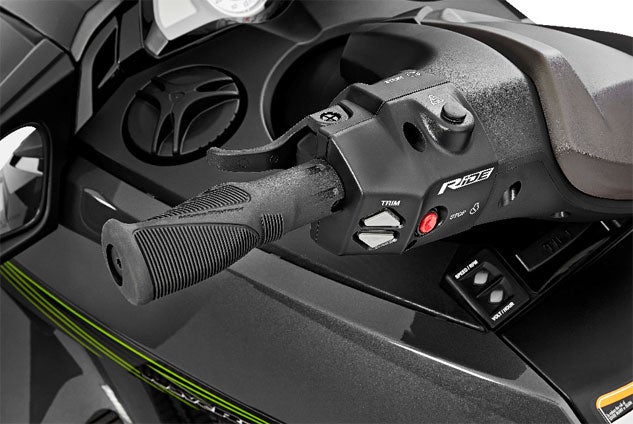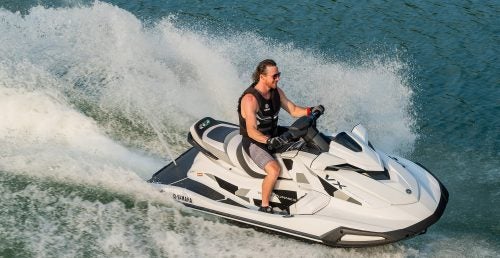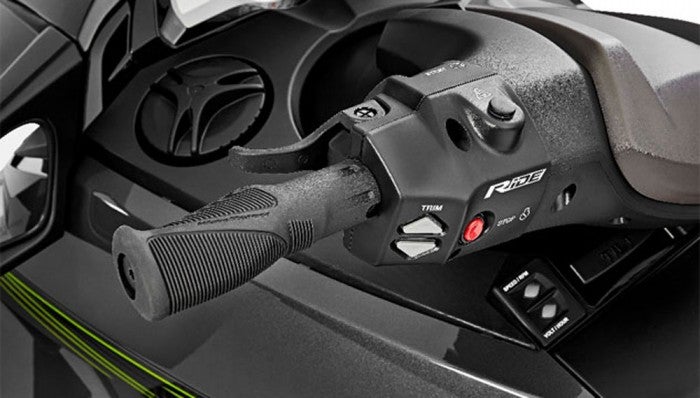Yamaha Introduces Dual-Lever “RIDE” Controls
Intuitive system adds deceleration, neutral and reverse to handlebar controls
For Yamaha in 2014, it’s all about the ride. In the figurative sense, the brand is further fine-tuning the end-user driving experience, hoping to make operating a WaveRunner simpler, easier, and more intuitive. In the literal sense, it is introducing a new “dual throttle” technology called, what else, RIDE, short for Revolutionary Intuitive Driving Experience.
Is it just that…revolutionary and intuitive? Read on.
Say You Want a R-Evolution
Though touted in company press materials as the “most significant enhancement to PWC in the last 30 years,” RIDE is really more of an evolution of the Intelligent Brake & Reverse system introduced by Sea-Doo in 2009. Like iBR, RIDE features the standard right-hand throttle along with a new lefthand lever that activates a redesigned reverse bucket. By deploying that bucket, a driver can effectively slow forward momentum, mimic a neutral setting, and put a RIDE-equipped craft into reverse. The system uses both the craft’s ECU and a BCU (boat control unit) to interpret rider input and translate it into movement at the reverse bucket actuator. Rather than a one-piece-fits-all solution, that latter duo are calibrated to the power and weight of each individual model, ensuring that the response is appropriate for the weight, size and power of each craft.
Get the Flash Player to see this player. |
Though the systems are overall quite similar, they do have their differences. Unlike iBR, RIDE doesn’t “switch” between distinct settings or theoretical gears as much as flow from one operation to the next. True, at startup it maintains a neutral setting and waits to be shifted into forward or reverse by the appropriate input. But once underway, the left-hand RIDE lever behaves much more like the “secondary throttle” for deceleration and reverse that Yamaha touts. Squeezing the lever at speed not only slows the craft, but once stationary, keeps that speed on to launch the craft into reverse. As RIDE is a throttle, you can also actually choose the force of water bouncing off that reverse gate, giving you surprising power while backing.
RIDE boasts an edge in terms of reverse agility. Unlike the iBR bucket design, Yamaha pushes deflected water completely out to the sides of the bucket. This gives a RIDE-equipped model the feeling of a “virtual rudder” in reverse, with the craft responding almost immediately to directional input at the helm with virtually no hesitation or directionless wandering. The addition of thrust just adds to the swiftness of the response. As that water exits the side, RIDE also slows the boat with no dramatic change in running attitude. This eliminates the brief bow drop experienced during hard, full-speed braking on a Sea-Doo. In fact, during a full day of testing RIDE-equipped models I found myself not once hesitant to pull the RIDE lever at full speed, something I would do with care (and a definite shift of weight toward the stern) on an iBR-equipped Sea-Doo. But though RIDE doesn’t appear to slow a craft with the initial force of iBR, the overall stopping distance seems relatively similar. A true head-to-head comparison may show different, but from the seat-of-the-pants perspective, both systems appear to achieve similar results.
Get the Flash Player to see this player. |
Power at Your Fingertips
Considering that for years Yamaha steadfastly refused to move the reverse lever to the port side of any craft precisely so that riders could not simultaneously use throttle and reverse, I find it interesting that RIDE can actually come on surprisingly strong when applied during slow-speed maneuvering. As you might expect, the difference is most notable on craft with more powerful engines. At times, it can be a definite plus, as the added force can get you out of trouble or keep you from hitting a dock or obstacle. This is a level of power not available through Sea-Doo’s iBR. At other times, however, RIDE definitely demands a gentle hand. Grabbing a handful of reverse in a tight spot (think marina or restaurant docks) can have you quickly surging backward with more momentum than you may have anticipated. Beginners may get into trouble from the powerful response, but experienced riders will likely learn the subtleties. After just a few minutes playing with RIDE, I was confidently maneuvering a tight marina slip without fear of drawing unwanted attention…or dinging up an attractive new 2015 Yamaha. Still, it’s more powerful than I think the response should be, or at least it is in the pre-production models available during the company’s 2015 press intro. It will be interesting to see if Yamaha tames that power slightly by production.
Get the Flash Player to see this player. |
Other twists to RIDE? Though company reps noted you should be able to use both controls at once to actually continue a turn during deceleration, I didn’t find that to be the case. Grabbing the RIDE lever overrules the throttle, and the result was my craft tended to drift forward without much directional control when I attempted the maneuver in a turn. It’s not a fault, but rather closer to how I would expect the system to work. And with practice, you can learn to blip the RIDE lever to slightly scrub off speed and plant the bow, before releasing the lever to power through a turn.
Leap Forward in the Yamaha Driving Experience
Surely the debates will rage as to whether RIDE is truly unique, or just Yamaha jumping on an existing bandwagon. But in the end, does it really matter? Just like cruise control and no-wake modes, or for that matter even trim and adjustable tilt handlebars, an evolution in control appears to be satisfying consumer demand and producing better, safer, more easy-to-operate craft.

And that, as the saying goes, is a good thing. After all, the point of all these fancy new technologies is to simply help you enjoy the lowercase ride. If an uppercase RIDE makes it that much better, we’re all the winners.
For 2015, RIDE technology will be featured on the FX Cruiser SVHO, FX SVHO, FX Cruiser SHO, FX SHO, FX Cruiser HO, FX HO, as well as the all-new platform VX, VX Deluxe, VX Cruiser, VXR and VXS.
Get PersonalWatercraft.com in your Inbox!
Like PersonalWatercraft.com on Facebook
Comments
Most Popular

Remembering the Sea-Doo XP

2025 Yamaha JetBlaster PRO 2-Up Review

2024 Yamaha GP HO Review

2024 Kawasaki Jet Ski STX 160X Review

2017 Kawasaki Jet Ski Ultra 310LX Review












 Your Privacy Choices
Your Privacy Choices